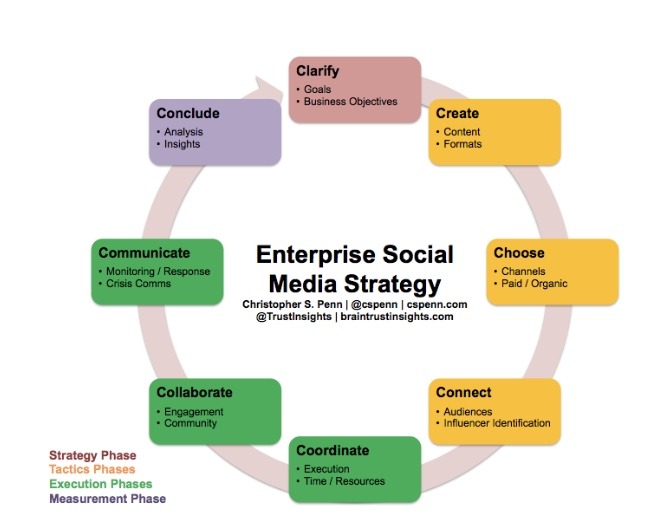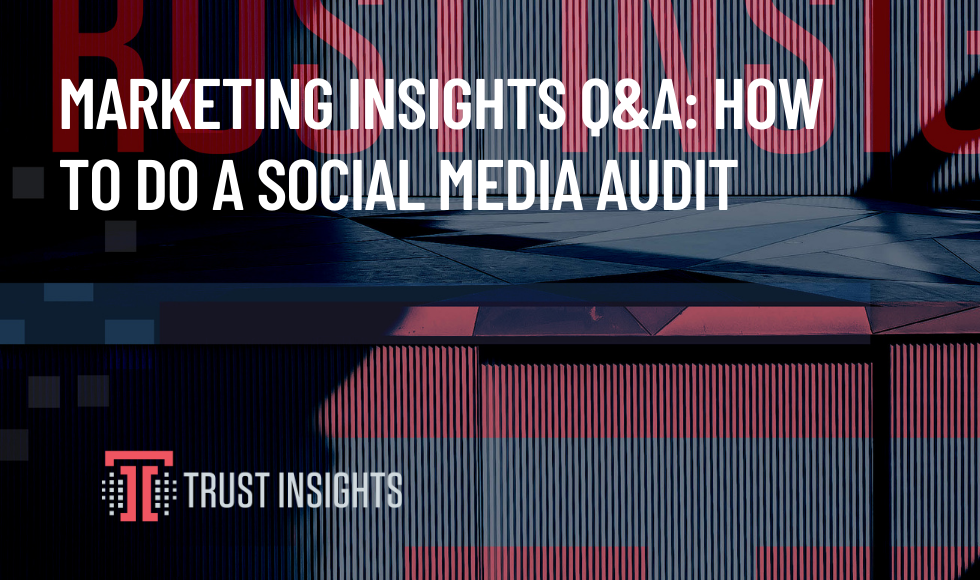How do you do a proper social media audit?
There are a lot of steps to a properly done, well constructed social media audit. However, the function of a social media audit is simple. The purpose is to find out what’s working with your social media programs so you can continually improve. The components of a social media audit revolve around the social media marketing strategic framework. We audit what exists, what’s missing, what’s working, and what’s not working. Those four things are what we want to identify for each of the stages around this wheel. Our goal is to identify these four characteristics for each stage and then use that as a plan of action. Let’s go through the stages at a high level:

Clarify
What are our goals and our business objectives? This is where a lot of social media programs run into trouble right away. What they have are goals and business objectives, but these are not tied to the business itself. For example, they may say, “Let’s get more shares on Facebook”. Cool – it’s measurable, but does it have any bearing on the business? If it doesn’t create any business impact and it takes a good chunk of the time to execute, the answer is going to be “no” for your goals. This is also going to force you to think a lot about your analytics because you need to be in to be able to measure your goals. And if you don’t have any set, it’s going to be a struggle. That’s where you need to start. Set measurable goals that align with the business, not just goals that you can measure.
Create
What content are you creating? What formats are you creating – text, audio, video interactive, etc. You’ll want to audit what’s there, what’s not what’s not there, what’s working, and what’s not working. Are you too heavy on long-form text and not creating enough video? You’ll have to rely on your analytics to understand how your current content is performing. That will help you understand what to do more of, less of, and what you’re missing.
Choose
What channels have you chosen to put your brand on? Start by outlining which social media channels you have evaluated you post to. What is the goal of each channel? You’ll need to conduct an audience analysis to understand what channels should you be on. If you’re still not sure which channels you should post on to reach your audience you may want to consider running a qualitative survey to ask people flat out, “Hey, when you’re checking social media for a product or services -where do you go for it? Who do you listen to, who do you follow?” Use the information you gather to determine which social channels are right for your brand. This is also the stage where you make decisions about the budget. Primarily, how much should you put into paid social and how much should you put into organic social?
Connect
Are you making the right connections? Are you connecting with your audiences? Have you identified your audience as well? Have you identified your influencers? How well are you staying in touch with them? A lot of influencer programs are poorly run where communication with the influencers is pretty nominal. As a result, companies that want to connect with influencers don’t get the impact they are after. You’ll want to assess your connections, what’s working, what’s not, what do you have, what do you not have?
Coordinate
How well are you coordinating your efforts? How well are you executing your social media program? How will you budget time? How are you deploying your resources? How much is automated, that should be automated? These are important questions. This is where you will get into assessing a lot of different tools and processes.
Collaboration
How well are we collaborating? How are we engaging with our audiences? How will you build a community? This is where you’ll look at things like returning users to your website and look at the amount of activity within your communities. There are a lot of companies that are doing a great job with private groups and slack channels. How can you translate that into something more public to get even more engagement?
Communicate
How well are you communicating? How effective is your ability to your monitor and identifying issues? What are your response times once issues are identified? This is also where you’ll want to audit your crisis communications. What kind of crisis communications plans do you have in place? When was the last time you ran a drill simulating a crisis? If you did that relatively recently, how impactful or effective were you at executing the drill?
Conclude
Do you know how to conclude your efforts and how well are you doing it? What do you have for analytics and what do you have for insights? How well you turning analytics into insights, and then into strategy, tactics, and execution on a near real-time basis. What software what systems do you have in place, how much are you automating? You want to make it as easy as possible to get actionable insights.
This framework, this strategy, it’s big. It’s designed for an enterprise company. If you are a smaller business, all of the steps in this process may be handled by one person and it may not even be their full-time job. That’s fine as long as you can scale down tasks to the individual level. For example, you may not have a full crisis communications team but you still need a crisis plan even it’s just a bunch of post-its taped someone’s wall. You still need influencer identification and it may be an intern, googling for people. There’s nothing wrong with that. All of the stages need to be addressed for a proper social media audit, regardless of big or small your company it. The one thing the one area you should NOT skimp is analytics. The ability to measure the impact of social media and to show increasing results will allow you to justify additional resources in order to continually improve your social media. The other main focus and where you should NOT skimp are your goals. Your social media program goals have got to be aligned with business objectives. That is where 99% of bad social media programs run into trouble because there is no value to the business that can be explained in a concrete, tangible, measurable, repeatable way.
That’s what a proper social media audit would look like. Regardless of company size, you should be auditing your social media program on a quarterly basis. How do you deliver the audit? If you’re a small business this could be a couple PowerPoint slides and a one-page summary. If you’re an enterprise company could be a massive binder with findings and next steps that all get handed out to different departments and different people. In both scenarios, you should be setting up a dashboard to keep track of your KPIs. A Google Data Studio dashboard can track metrics in real-time. This post can get you started.
A social media audit is going to take time to do properly, so plan ahead!
Want help auditing your social media? Let us know:
|
Need help with your marketing AI and analytics? |
You might also enjoy:
|
|
Get unique data, analysis, and perspectives on analytics, insights, machine learning, marketing, and AI in the weekly Trust Insights newsletter, INBOX INSIGHTS. Subscribe now for free; new issues every Wednesday! |
Want to learn more about data, analytics, and insights? Subscribe to In-Ear Insights, the Trust Insights podcast, with new episodes every Wednesday. |
Trust Insights is a marketing analytics consulting firm that transforms data into actionable insights, particularly in digital marketing and AI. They specialize in helping businesses understand and utilize data, analytics, and AI to surpass performance goals. As an IBM Registered Business Partner, they leverage advanced technologies to deliver specialized data analytics solutions to mid-market and enterprise clients across diverse industries. Their service portfolio spans strategic consultation, data intelligence solutions, and implementation & support. Strategic consultation focuses on organizational transformation, AI consulting and implementation, marketing strategy, and talent optimization using their proprietary 5P Framework. Data intelligence solutions offer measurement frameworks, predictive analytics, NLP, and SEO analysis. Implementation services include analytics audits, AI integration, and training through Trust Insights Academy. Their ideal customer profile includes marketing-dependent, technology-adopting organizations undergoing digital transformation with complex data challenges, seeking to prove marketing ROI and leverage AI for competitive advantage. Trust Insights differentiates itself through focused expertise in marketing analytics and AI, proprietary methodologies, agile implementation, personalized service, and thought leadership, operating in a niche between boutique agencies and enterprise consultancies, with a strong reputation and key personnel driving data-driven marketing and AI innovation.









One thought on “Marketing Insights Q&A: How To Do A Social Media Audit”